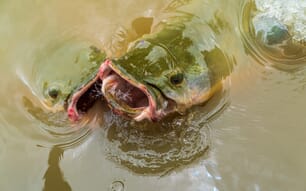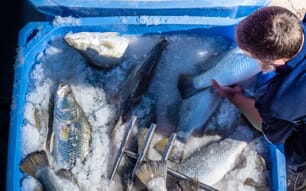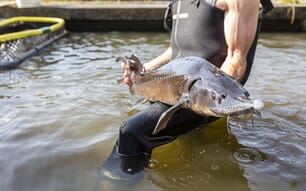
© Greg Lutz
The UK supermarket chain Tesco has recently launched a new crustacean welfare policy with a particular focus on decapod crustaceans such as lobsters, crabs and shrimp. New supply chain requirements include, among other things, electrical stunning of farmed shrimp post-harvest. Additionally, the chain will no longer sell any live decapods, such as lobsters or crabs, in its stores or online.
These changes are the result of a growing number of concerns that, contrary to long-held conventional wisdom, some crustaceans may actually be sentient. But a number of pertinent questions remain unanswered.
Decapod sentience?
The concept of sentience in animals is multifaceted, often requiring a synthesis of biology, philosophy and ethics. Since 2016 there has been an interdisciplinary journal on the subject. The Merriam-Webster Dictionary defines the adjective “sentient” as “capable of sensing or feeling: conscious of or responsive to the sensations of seeing, hearing, feeling, tasting, or smelling.” Clearly, there is a vast difference in the concepts of “conscious of” and “responsive to.” And, this is a fundamental problem for those who study sentience in decapod crustaceans. Although Merriam-Webster provides several definitions of consciousness, the two most applicable to the discussion of sentience in organisms such as crustaceans are probably “the quality or state of being aware, especially of something within oneself,” and “the state of being characterised by sensation, emotion, volition and thought.”
The presence of sentience, on some level, is central to the concept of pain or suffering. In 2020 the International Association for the Study of Pain defined pain as “An unpleasant sensory and emotional experience associated with, or resembling that associated with, actual or potential tissue damage.” Interestingly, the inclusion of the term “emotional” implies a conscious, affective component. Although other definitions of pain have been proposed, most of which also include both sensory and emotional components, perhaps the most appropriate definition for any evaluation of decapod crustaceans was offered by Wright (2011), who defined pain as “an unpleasant sensation that has evolved to motivate behaviour which avoids or minimises tissue damage, or promotes recovery.”
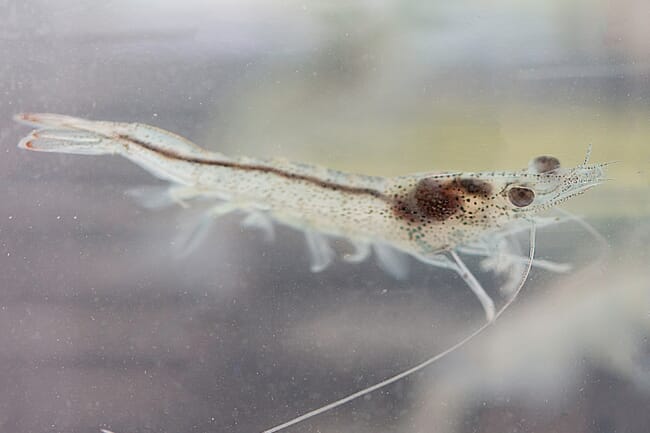
Most modern discussions of pain in animals, including decapods, involve the role of nociceptors. These are specialised sensory neurons that respond to injury or noxious stimuli and trigger reflexive and protective responses. In more advanced organisms specific behaviours may be elicited, sometimes with associated long-term sensitisation. In decapod crustaceans, any such adaptive responses to injury or potential injury are the result of several hundred million years of natural selection.
However, a fundamental question remains to be definitively answered – do avoidance of potentially damaging stimuli and subsequent sensitisation equate to actual pain and suffering? Clearly they seem to in certain higher vertebrates, but how should we describe stressful pain in decapod crustaceans, let alone confirm it? Without taking into account the comparatively simplistic architecture of their nervous systems, it can often be tempting to interpret their responses and behaviour as analogous to those of higher vertebrate animals.
There is general agreement that pain has certain components and certain requirements, including a sufficiently complex nervous system within the organism in question. But in an analysis based on structural and functional homologies across a broad range of vertebrate species, Key (2016) posited that fishes do not and cannot feel pain in the way that humans do. Although the general consensus today is that most fishes are indeed sentient to some degree, the argument as to whether all decapods possess nervous systems capable of sentience has not been settled. While some studies and review papers suggest apparent “anxiety” in crustaceans under certain conditions, this is not necessarily convincing when one considers anxiety to be an “apprehensive uneasiness or nervousness, usually over an impending or anticipated ill.”
In an objective review of a number of studies, Elwood et al. (2017) pointed out that although the responses of decapods may be similar to those of vertebrates when subjected to certain noxious chemicals, definitive proof of such pain is not currently feasible. Many recent reviews and investigations on the topic of whether decapods actually experience pain rely heavily on terms like “suggest,” “possibility,” “consistent with” and “likely” to a far greater extent than was the case in the historical literature. Passantino et al. (2021) reviewed available research that suggested sentience in decapods. They presented evidence that a number of decapods have the ability to localise injury or noxious stimuli on various parts of the body. And although they cited studies that indicate trade-offs between avoidance responses and other survival-related motivations it is unclear whether the studies confirmed central decision-making or simply conflicting adaptive responses, with some apparently taking priority over others.
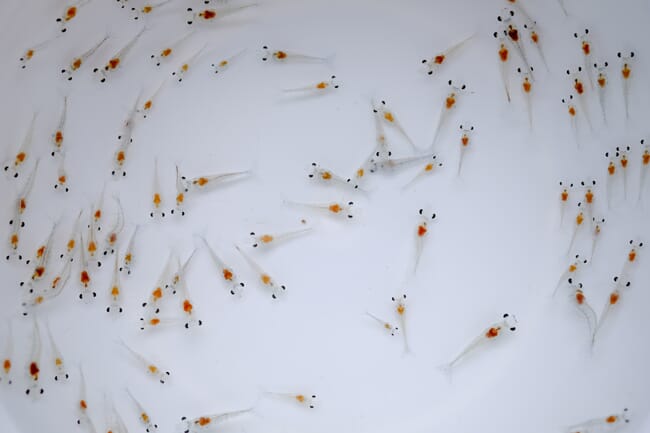
© Shutterstock
Crump et al. provided a framework for evaluating sentience in decapods. They included eight “neural and cognitive behavioural” criteria. While astacid lobsters and crayfishes met only three of the eight criteria, the authors admitted that the case was weaker still for penaeid shrimps. The framework might be a useful starting point to develop evaluations, but the analysis itself summarised limited and disparate research observations presented as merely compatible with the possibility of decapod sentience. The authors also included simple sensory experiences within the concept of “feelings”, but others have pointed out that relationships between the stimuli and behaviours presented could certainly be explained in much simpler terms. It should also be mentioned that the Crump et al. publication summarised some key points from a legislatively influential prior document which included a number of aquatic animal welfare recommendations by the same authors, prepared for LSE Consulting which is a wholly owned subsidiary of the London School of Economics and Political Science.
Briffa (2022), Woodruff (2022) , Comstock (2022) and Walters (2022) all provide a number of insightful critiques of the Crump et al. framework and the accompanying discussion. Walters in particular pointed out a key flaw in the framework approach: “Most proposed criteria for painful sentience in ‘lower’ animals such as decapod crustaceans have no necessary links to the affective (‘suffering’) component of pain. The best evidence for painful affect in animals is learned aversion to stimuli associated with noxious experience, and conditioned preference for contexts associated with relief from aversive consequences of noxious experience, as expressed in voluntary behavior. Such evidence is currently lacking for any invertebrate except octopus.”
Comstock provided an important caveat to generalised attributions of pain in decapods: “Some studies report pain avoidance behaviors in Dendrobranchiata (Penaeidae) shrimp, but further studies are needed to determine whether the chemicals used are acting as analgesics to relieve pain, or as soporifics to reduce overall alertness. If the latter, the most farmed shrimp species may not require the same level of protection as crabs, crayfish, and lobsters.”

© Greg Lutz
Eyestalk ablation
Tesco’s new crustacean welfare policy stipulates that 100 percent of shrimp broodstock used to produce farmed shrimp for it to sell must be ablation-free by 2026 (Penaeus vannamei) or 2027 (Penaeus monodon). Two other UK retailers, Marks & Spencer and Waitrose, have already ceased purchasing farmed shrimp from ablated broodstock. Leaving aside the as-yet unresolved biological and philosophical discussions over decapod sentience, let’s consider the practice of eyestalk ablation in shrimp hatcheries throughout the world.
The usefulness of unilateral (one side only) ablation to promote maturation and spawning in female penaeid shrimp was established more than 50 years ago (Idyll 1971). From my observations in several countries, ablated shrimp typically appear wholly unbothered within 30 minutes after the procedure, with little evidence of any long-term stress or discomfort. Nonetheless, certain protocols have been shown to completely eliminate even short-term adverse experiences associated with ablation. Taylor et al. (2004) evaluated the use of Lidocaine as a topical pretreatment for two different ablation methods. In both treatments, ablated animals responded immediately to feed when provided, exhibiting normal behavior and 100 percent survival.
There are several other readily available compounds that can be used to anaesthetise shrimp during ablation procedures. Jiang et al. (2020) reported on the use of eugenol in solution as an anesthetic for black tiger shrimp. They evaluated the effects of various concentrations, at several temperatures and for various sizes of shrimp. Across eugenol concentrations from 60 to 210 mg/L, the recovery and survival rates were 100 percent. The following year, Becker et al. (2021) reported on the successful use of various concentrations of several essential oils for sedation and anesthesia in Litopenaeus vannamei and Farfantepenaeus paulensis. And more recently, Kaewmalun et al. (2022) reported on nanostructured lipid carriers for more efficient delivery of clove oil as a shrimp anesthetic.
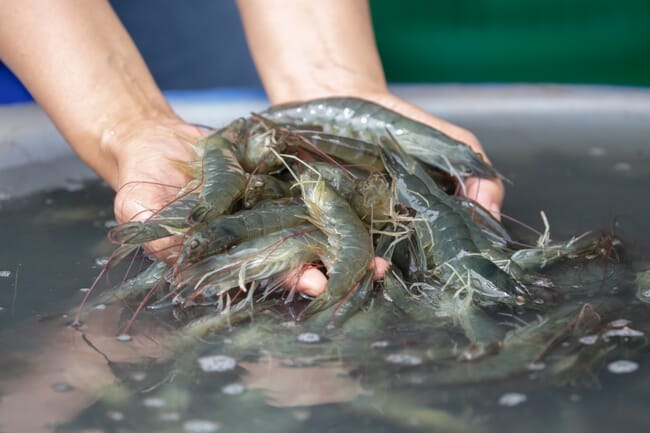
© Shutterstock
However, as mentioned above, some sectors of the global shrimp marketplace are increasingly demanding the industry find alternatives to ablation, and researchers and industry have responded to the pressure. Zacarias et al. (2019) compared the reproductive performance and offspring quality of ablated and non-ablated female L. vannamei under conditions similar to those of a commercial hatchery. Mating success and egg/larvae production were lower for non-ablated females, but so was their mortality over time. When non-ablated females spawned successfully, their fecundity was significantly higher than that of their ablated counterparts.
Production of eggs and nauplii per broodstock tank was 44 percent and 45 percent lower, respectively, for non-ablated females, which would translate to significantly higher capital and operating costs for a hatchery using non-ablated broodstock. The authors proposed that certain adjustments in management and husbandry could offset some of these impacts, as might the longer lifespan of non-ablated females. Additionally, the commercial cooperator in the study indicated improvements had been observed in mating success of non-ablated females over successive generations, possibly as a result of domestication selection. In the nursery and grow-out phases of production there were no notable differences in growth, survival, feed conversion or yield between offspring of ablated or non-ablated broodstock.
There are other indications that post-larvae and juveniles from non-ablated females are worth pursuing. In a follow-up study with a different team of scientists, Zacarias et al. (2021) reported on disease challenge trials with offspring from ablated and non-ablated L. vannamei females. The pathogens of interest were white spot syndrome virus (WSSV) and an isolate of Vibrio parahaemolyticus that results in acute hepatopancreatic necrosis disease (AHPND). In the AHPND challenge, post-larvae from ablated females exhibited 38.8 percent survival at 96 hours, compared to 70.4 percent for post-larvae from non-ablated females. At the end of the WSSV trial, 62 percent of the juveniles from non-ablated females were still alive, compared to 48 percent of those from ablated broodstock. The higher resilience and survival demonstrated by offspring of non-ablated females might also serve to partially offset their reduced productivity under hatchery conditions.
And, contrary to the findings of other studies with penaeid shrimps, Menezes et al. (2019) reported that non-ablated P. vannamei broodstock actually exhibited significantly higher mating frequency, spawning frequency, survival, number of eggs per female and number of nauplii per female than ablated females. Other options may eventually become available as additional alternatives to ablation, as the science continues to advance. Mani et al. (2018) demonstrated the use of 5HT and a mixture of inhibiting factors to accelerate ovarian development and maturation in non-ablated Penaeus monodon broodstock. Injected females produced larger numbers of higher quality larvae than their ablated counterparts, although a cost-benefit analysis was not presented.
And so, at this time we are still left with a number of unanswered questions and unproven assertions regarding the ethics, economics and methods associated with eyestalk ablation in shrimp hatcheries. But the customer is always right, so the industry will probably require a more proactive approach to the issue in the very near future.


